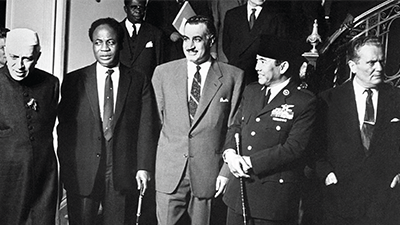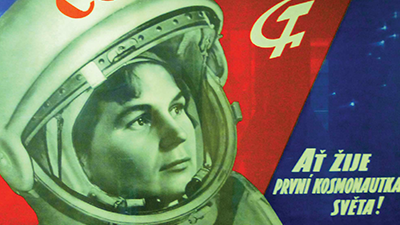Origins of the Cold War
Teacher Resources
Driving Question: What led to the competition between Soviet-style communism and American capitalism?
After the Second World War, the world’s two strongest nations championed opposing visions for the world. Learn how competing ideologies, broken economies, and new weapons set the stage for a high-stakes global conflict.
Learning Objectives:
- Use evidence to understand how economic and political systems fueled early Cold War tensions.
- Use the historical thinking practice of sourcing to evaluate different points of view regarding what led to the Cold War.
Vocab Terms:
- containment
- decolonization
- ideological
- intervention
- nuclear
- protest
- superpower
- union
Opener: Origins of the Cold War
To teach this lesson step, refer to page 2 of the Lesson 8.2 Teaching Guide.
World War I, Russia, and Propaganda provided us a ton of resources for analyzing the past. Learn how other teachers guide students to analyze propaganda material in this Community thread.
The origins of the Cold War revolve around two opposed ideologies. Can you tell what’s capitalism and what’s communism?
What Caused the Cold War?
To teach this lesson step, refer to page 3 of the Lesson 8.2 Teaching Guide.
For reading strategies, take a look at the OER Project Reading Overview.
Need a way to give students feedback on their sourcing skills? Check out this Sourcing Feedback Form.
Dive into the early tensions that sparked the Cold War. Discover how the race for influence, clashing ideologies, and new global challenges reshaped the world after 1945.
-
Guiding Questions
-
Before you read
Preview the questions below, and then skim the article. Be sure to look at the section headings and any images.
While you read
Look for answers to these questions:
- Why did the United States create the Marshall Plan?
- What are the two explanations for the economic recoveries in Germany and Japan?
- How did former colonial powers maintain economic control after independence?
- What strategies did African and Asian leaders use to resist economic dependency?
- Who was left out of postwar prosperity in the United States?
After you read
Respond to this question: How did decolonization and the Cold War together reshape global production and distribution after 1945?
-
Guiding Questions
-
Before you read
Preview the questions below, and then skim the article. Be sure to look at the section headings and any images.
While you read
Look for answers to these questions:
- What was the basic conflict at the center of the Cold War?
- What were the three main features of the Cold War?
- Why did Stalin want greater Soviet influence in Eastern Europe?
- What was the policy of containment, and what example shows it in action?
After you read
Respond to this question: Which of the course frames best explains the causes of the Cold War, and why?
Mutually Assured Destruction
To teach this lesson step, refer to page 9 of the Lesson 8.2 Teaching Guide.
Curious about how other teachers approach the Cuban Missile Crisis simulation? Find additional resources and learn more by checking out the Community thread How do you incorporate decolonization and the Cold War?
The Cold War wasn’t just about politics—it was about survival. Learn how the arms and space races fueled global tensions and how leaders navigated the threat of nuclear war.
-
Guiding Questions
-
Before you read
Preview the questions below, and then skim the article. Be sure to look at the section headings and any images.
While you read
Look for answers to these questions:
- What was the arms race?
- What does MAD mean?
- What was the Cuban Missile Crisis?
- How did the Cuban Missile Crisis affect international relations?
- How was the space race linked to the arms race?
After you read
Respond to this question: Do you think the space race offered hope for greater international cooperation, or was it just another extension of Cold War competition? Use evidence to support your answer.
Closer: Origins of the Cold War
To teach this lesson step, refer to page 13 of the Lesson 8.2 Teaching Guide.
The Cold War ended in 1991…right? Find answers to this Cold War question by reading this blog.
The Cold War had many hot spots. In this activity, you’ll choose one Cold War event and write a breaking news story from a perspective of your choice.
A Cold War World
To teach this lesson step, refer to page 13 of the Lesson 8.2 Teaching Guide.
The Cold War shaped the second half of the twentieth century through a fierce rivalry between two superpowers. Explore how the competition unfolded across the world.
-
Guiding Questions
-
Before you watch
Preview the questions below, and then review the transcript.
While you watch
Look for answers to these questions:
- What evidence supports the claim that the Cold War was a “clash of civilizations”?
- Why did the Cold War start during World War II?
- What was the Marshall Plan?
- What is MAD?
- What are some examples of how Soviets and Americans fought indirectly?
After you watch
Respond to this question: How does focusing only on US and Soviet actions limit our understanding of the Cold War as a truly global conflict?






